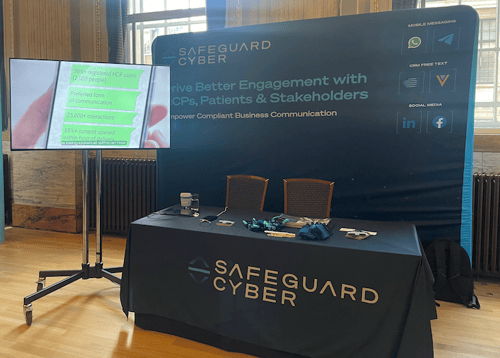The SafeGuard Cyber team just returned from the Digital Pharma Advances Conference in London. We learned a ton; too much for one blog! But one of the biggest things that jumped out to us was the topic of how pharma marketers can produce good, engaging content – while staying within the rules, and adapting to the changing behavior of HCPs.
The internet transformed the way that healthcare professionals (HCPs) access information. Long reliant on pharmaceutical representatives for the latest news and product information, they were suddenly able to turn to an array of digital channels for unbiased perspectives and up-to-the-minute data.
For HCPs, this information freedom has largely been empowering. It’s enabled professionals to learn more, access more, and synthesize more. For pharma marketers, the internet era has brought new pressures. They need to produce content that is compliant with strict regulations – while remaining engaging and informative.
It’s a delicate balance, but one that can be achieved with the help of (1) digital engagement experts and (2) the compliant adoption of two-way communication channels such as social media and WhatsApp.
Understanding Customer Needs through Content and Engagement
 Pharma companies lag in digital engagement as an industry. This isn’t surprising: data-heavy pharma content isn’t something most people would find entertaining or engaging.
Pharma companies lag in digital engagement as an industry. This isn’t surprising: data-heavy pharma content isn’t something most people would find entertaining or engaging.
However, pharma marketers are trying to catch up. They want to create content that is interesting and engaging and tailored to their audience’s specific needs. Good content should change behavior, assisting HCPs in making informed decisions that improve patient outcomes.
For example, as a cybersecurity professional, my work has helped empower our customer companies with solutions and insights that enable secure, compliant communications, whether for HCP or DTC (direct-to-consumer) use. Though effective for customer communications, tools like social media and WhatsApp are extremely vulnerable to cyberattacks and compliance risks. It is our responsibility as cyber professionals to help highly-regulated companies safeguard their data and systems.
Likewise, other digital leaders have a lot of insight into how customers interact with their brands online. By understanding the customer journey and using data to segment customers, they can create targeted campaigns encouraging the desired behavior.
This is especially important for pharmaceutical companies, as there is an excellent opportunity to use digital channels to increase patient adherence and improve outcomes. Digital campaigns that engage patients in their treatment journey and provide support can significantly impact patient behavior. A great example is AstraZeneca’s use of Spotify Playlist for their Patient-Centered Assessment Method (PCAM).
Innovation is key in digital marketing, as users constantly look for something new and engaging. Products that encourage interaction with the brand can help customers feel connected and heard, which leads to an increase in loyalty. The goal is to help customers make the journey from awareness to action and beyond, creating a lasting impact on their behavior.
However, content aimed at HCPs can’t only be good – it also needs to be compliant. This is where a balance needs to be struck.
Measuring Impact Across the Organization
Engagement metrics play a critical role in measuring the success of customer journeys and optimizing campaigns across multiple platforms. Metrics enable agile marketing approaches, which involve testing, learning, and reiterating until desired outcomes are achieved. It’s not an exact science, and compliance needs to be ensured 100% of the time, but accurate measurement is powerful.
To this end, CRM systems and messaging apps have become increasingly helpful as they help create personalized customer experiences. Enterprises now use these tools to measure agent productivity, customer satisfaction, and ROI. Digital marketers can tailor content to fit each segment, and automated triggers allow for timely responses that are more engaging than manual processes. Organizations can track user activity, identify trends, and take actionable insights from the data collected.
With this level of agility and focus on metrics, digital marketing teams are at the forefront of successful customer engagement strategies. Organizations should capitalize on these opportunities by leveraging data-driven insights to create personalized journeys tailored to individual needs and preferences. In doing so, they will have greater control over the success of their initiatives – both from an engagement standpoint and a financial perspective.
Everything that is true of this agile marketing model in other verticals is true when it comes to pharma. Those producing content aimed at HCPs and adjacent readers should approach their work with the same focus on measurement and optimization.
Risk vs. Reward in Digital Transformation
 Digital transformation has become a significant focus for organizations today, and it’s only accelerated since the pandemic.
Digital transformation has become a significant focus for organizations today, and it’s only accelerated since the pandemic.
COVID presented unprecedented challenges which could only be solved through digital transformation. For instance, it was an opportunity for healthcare providers to pivot to offering hybrid or virtual care instead of relying solely on in-person visits. Various pharma and healthcare organizations rapidly deployed remote monitoring technologies, and remote patient engagement tools were put into place – all necessary changes to provide care at a time when people were reluctant or unable to visit the doctor’s office.
But even then, with all the technology between patient and provider, the human touch remains essential. In a rapidly evolving environment, one constant that patients continue to seek from their communications is the feeling of human conversation.
Many increasingly recognize the need to make quick decisions that have long-term business consequences. After all, failing to move quickly can result in lost opportunities and reduced engagement. Organizations must balance this rapid digital transformation with the risk versus reward of making such sweeping changes. Case in point: In Marisa Muninger’s presentation at the conference, on Sanofi’s Internal Change and Digital Transformation, she offered an insightful look at how the company embarked on transforming its pharma culture and mindsets to boost digital adoption, upskill all teams, and drive customer-centricity.
However, with the recent increase in cases of cyberattacks on healthcare organizations and pharma companies, there is always risk associated with these changes.
One way to offset this risk is by ensuring that you have the right team in place – a team that is not only knowledgeable about digital transformation but also understands the importance of cybersecurity. It is crucial to have an omnichannel approach that creates a “Digital Entitled” representative who can help guide customers through their journey.
By taking these steps, you can create a balance between risk and reward that will help your organization succeed in today’s rapidly changing environment.
Preparing for the Future
Understanding customer needs, measuring impact, and balancing risk vs. reward in digital transformation – these and more are what enterprises in the pharmaceutical industry should focus on in the coming years. But as customer demand continues to evolve, pharma companies must realize that technology is also providing them the means to meet these demands.
Digital channels enable pharma companies to engage HCPs to get unbiased perspectives and up-to-date data, so long as they ensure compliance. Two-way communication tools like WhatsApp and social media can be used to their full potential when the risks that come with them are taken care of.
We had a great time at the Digital Pharma Advances Conference in London, and we can’t wait to go back next year!
